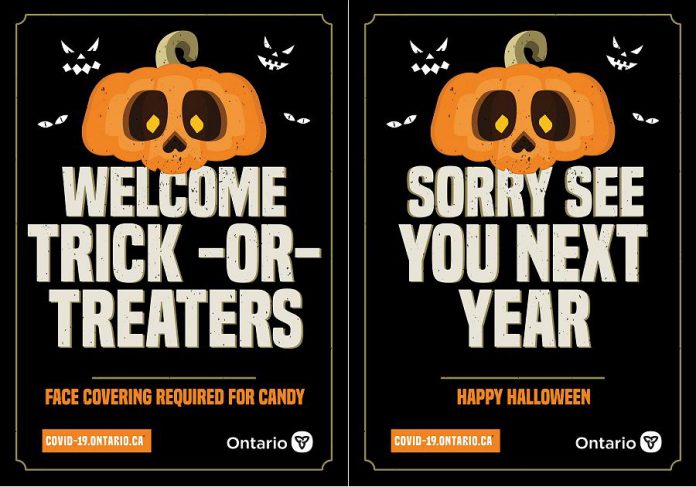With the first Halloween of the pandemic less than two weeks away, Ontario’s chief medical officer of health Dr. David Williams has provided public health advice for safely celebrating Halloween.
“As Ontarians begin to prepare for Halloween this year, I’d like to remind everyone to take extra precautions to ensure you are keeping yourself and your families safe,” reads a statement for Dr. Williams.
In the province’s four COVID-19 hotspots of Ottawa, Peel, Toronto, and York Region, Dr. Williams is recommending against traditional door-to-door trick-or-treating.
Instead, residents of these four areas should consider alternative ways to celebrate, such as encouraging kids to dress up and participate in virtual activities and parties, organizing a candy hunt with people living in your household, carving pumpkins, having a movie night or sharing scary stories, and decorating front lawns.
In all other areas of Ontario, Dr. Williams states that traditional trick-or-treating is okay as long as the following recommendations are followed:
- Only go out with members of your household.
- Only trick-or-treat outside (e.g. not in apartment buildings).
- Both trick-or-treaters and people handing out candy should wear a face covering. A costume mask is not a substitute and should not be worn over a face covering because it may make it difficult to breathe.
- Do not congregate or linger at doorsteps and remember to line up two metres apart if you are waiting.
- Avoid high-touch surfaces and objects, such as railings and doorbells.
- Whether you are collecting or handing out treats, wash your hands often and thoroughly or use hand sanitizer.
Recognizing that some people may not feel comfortable handing out treats this year, Dr. Williams recommends letting neighbours know if you are participating by printing out one of the following posters.

Full-size versions of the posters are available to download from the Ontario government website (“Welcome trick-or-treaters” poster, “See you next year” poster). NOTE: The province has now made available versions of the posters with white backgrounds (probably after complaints about how much black ink would be used).
If you are giving out treats, Dr. Williams recommends using tongs or other similar tools to hand out treats rather than leaving them in a bucket or bowl for children to grab, which could help spread the virus.
“It is recommended that you also check with your local municipality or public health unit for any additional advice or restrictions that may be in place,” Dr. Williams states. “It is also critical that families not travel outside of their neighbourhood to celebrate Halloween.”
For all Ontarians, Dr. Williams also recommends avoiding gatherings with people outside of your household, and staying home if you are feeling ill — even if you have mild symptoms — or if you are at higher risk for serious illness from COVID-19.
“I would also like to remind everyone that we are in a second wave of COVID-19,” Dr Williams states. “There have been increases in cases in many areas across the province, and the percentage of people tested who get a positive result is going up. The severity of this second wave is in our hands. Through our collective efforts, we can change the outcome of this new outbreak.”



























